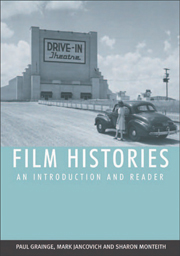Book contents
- Frontmatter
- Contents
- Preface
- Part I Film History from its Origins to 1945
- 1 The Emergence of Cinema
- 2 Organising Early Film Audiences
- 3 Nationalism, Trade and Market Domination
- 4 Establishing Classical Norms
- 5 The Age of the Dream Palace and the Rise of the Star System
- 6 Competing with Hollywood: National Film Industries outside Hollywood
- 7 The Rise of the Studios and the Coming of Sound
- 8 Realism, Nationalism and ‘Film Culture’
- 9 Adjustment, Depression and Regulation
- 10 Totalitarianism, Dictatorship and Propaganda
- 11 The Common People, Historical Drama and Preparations for War
- 12 Wartime, Unity and Alienation
- Part II Film History from 1946 to the Present
- Bibliography
- Copyright Acknowledgements
- Index
5 - The Age of the Dream Palace and the Rise of the Star System
from Part I - Film History from its Origins to 1945
Published online by Cambridge University Press: 05 August 2013
- Frontmatter
- Contents
- Preface
- Part I Film History from its Origins to 1945
- 1 The Emergence of Cinema
- 2 Organising Early Film Audiences
- 3 Nationalism, Trade and Market Domination
- 4 Establishing Classical Norms
- 5 The Age of the Dream Palace and the Rise of the Star System
- 6 Competing with Hollywood: National Film Industries outside Hollywood
- 7 The Rise of the Studios and the Coming of Sound
- 8 Realism, Nationalism and ‘Film Culture’
- 9 Adjustment, Depression and Regulation
- 10 Totalitarianism, Dictatorship and Propaganda
- 11 The Common People, Historical Drama and Preparations for War
- 12 Wartime, Unity and Alienation
- Part II Film History from 1946 to the Present
- Bibliography
- Copyright Acknowledgements
- Index
Summary
By the end of the First World War, the cinema was an established cultural fact in an era of rapid social change. In America, theatres or dream palaces were crucial to the structuring of the film industry. They were the places where cinema came to the masses and the studios successfully exploited such venues as they did the movie stars under contract to them. The first movie palaces were built in 1913. The story of Loew's Corporation in New York is representative. Building on his success and to secure his own suppliers of movies, Marcus Loew bought Metro Pictures in 1919 and went on to buy Goldwyn Pictures, creating Metro-Goldwyn-Meyer (or MGM) – what would become the most powerful studio of the 1930s. The vertical integration of aspects of the industry ensured a corporation like Loew's could control the manufacturing of films, their retailing and their exhibition.
In this period, audience concentration spans would stretch from short one-reel films to features of around seventy-five minutes in direct correlation with their worshipping of stars such as matinée idol John Barrymore, swashbuckler Douglas ‘the Great Lover’ Fairbanks, Rudolph Valentino and a host of beauties including Mary Pickford, Mae Murray, Gloria Swanson, Pola Negri and Greta Garbo. Cinema had begun by borrowing known quality from the theatre. In Germany Max Reinhardt, an acclaimed theatrical producer, had begun working in the cinema around 1910 and demonstrated a phenomenal ability to spot talent that would work in the studio as well as on the stage.
- Type
- Chapter
- Information
- Film HistoriesAn Introduction and Reader, pp. 93 - 119Publisher: Edinburgh University PressPrint publication year: 2007



